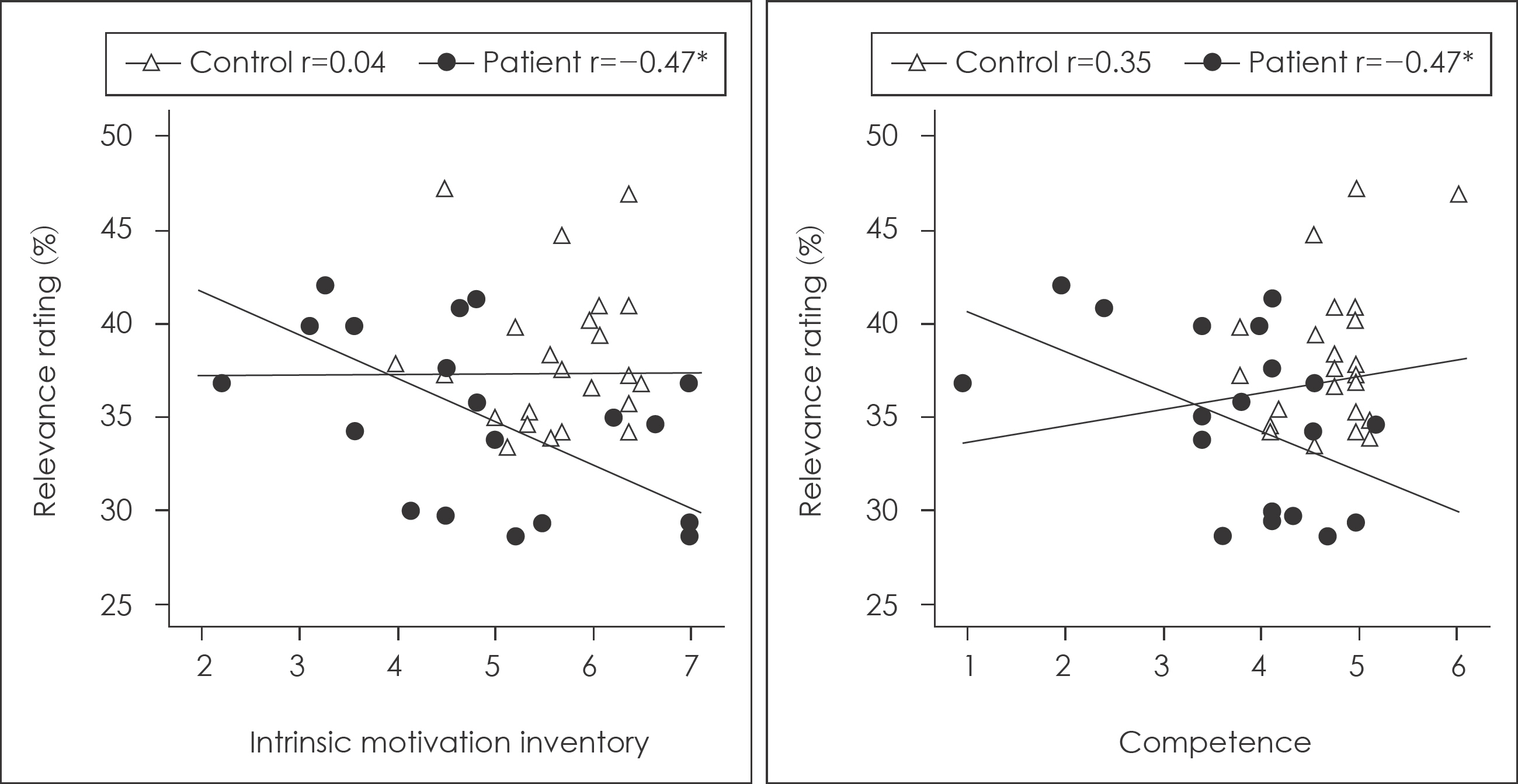Korean J Schizophr Res.
2015 Oct;18(2):73-78. 10.16946/kjsr.2015.18.2.73.
Relationship Between Self-Referential Processing and Intrinsic Motivation in Patients with Schizophrenia
- Affiliations
-
- 1Department of Psychiatry, National Health Insurance Service Ilsan Hospital, Goyang, Korea.
- 2Institute of Behavioral Science in Medicine, Yonsei University College of Medicine, Seoul, Korea. jaejkim@yonsei.ac.kr
- 3Graduate School of Education, Yonsei University, Seoul, Korea.
- 4Department of Communication, Yonsei University, Seoul, Korea.
- 5Department of Psychiatry, Yonsei University College of Medicine, Seoul, Korea.
- 6Department of Occupational Therapy, Chunnam Techno University, Gokseong, Korea.
- KMID: 2103935
- DOI: http://doi.org/10.16946/kjsr.2015.18.2.73
Abstract
OBJECTIVES
The close relationship between impaired self-referential processing and intrinsic motivation in schizophrenia has been suggested, but is not investigated yet. The purpose of this study was to explore the characteristics of self-referential processing and its relationship with intrinsic motivation in patients with schizophrenia.
METHODS
Nineteen patients with schizophrenia and 24 healthy controls performed a self-referential processing task, in which a face (self, familiar other, or unfamiliar other) and three words (positive, neutral, and negative nouns) were presented. Participants were asked to indicate which word is relevant to the face. Intrinsic motivation and basic psychological needs affecting intrinsic motivation were assessed using self-reports.
RESULTS
Compared to healthy controls, the relevance rating between self-face and neutral word was significantly lower in patients with schizophrenia (p=0.02). In patients with schizophrenia, it was negatively correlated with intrinsic motivation (r=-0.47, p=0.04) and competence (r=-0.47, p=0.05) which is known to influence intrinsic motivation.
CONCLUSION
These results suggest that there is an impairment in self-referential processing in schizophrenia and it is associated with an impairment in intrinsic motivation. In particular, amotivation in patients with schizophrenia may represent a facet of selfdisorder.
Figure
Cited by 1 articles
-
Characteristics of Ambivalence of Self-image in Patients with Schizophrenia
Byung-Hoon Kim, Yu-Bin Shin, Sunghyon Kyeong, Seon-Koo Lee, Eun Joo Kim, Jae-Jin Kim
Korean J Schizophr Res. 2016;19(1):5-9. doi: 10.16946/kjsr.2016.19.1.5.
Reference
-
1). Barch DM, Dowd EC. Goal representations and motivational drive in schizophrenia: the role of prefrontal-striatal interactions. Schizophr Bull. 2010; 36:919–934.
Article2). Barch DM, Yodkovik N, Sypher-Locke H, Hanewinkel M. Intrinsic motivation in schizophrenia: relationships to cognitive function, depression, anxiety, and personality. J Abnormal Psychol. 2008; 117:776–787.
Article3). Ryan RM, Deci EL. Self-determination theory and the facilitation of intrinsic motivation, social development, and well-being. Am Psychologist. 2000; 55:68–78.
Article4). Nakagami E, Xie B, Hoe M, Brekke JS. Intrinsic motivation, neurocognition and psychosocial functioning in schizophrenia: testing mediator and moderator effects. Schizophr Res. 2008; 105:95–104.
Article5). Reeve J, Nix G, Hamm D. Testing models of the experience of self-determination in intrinsic motivation and the conundrum of choice. J Edu Psychol. 2003; 95:375.
Article6). Gard DE, Sanchez AH, Starr J, Cooper S, Fisher M, Rowlands A, et al. Using self-determination theory to understand motivation deficits in schizophrenia: the ‘why' of motivated behavior. Schizophr Res. 2014; 156:217–222.
Article7). van der Meer L, Costafreda S, Aleman A, David AS. Self-reflection and the brain: a theoretical review and metaanalysis of neuroimaging studies with implications for schizophrenia. Neurosci Biobehav Rev. 2010; 34:935–946.
Article8). Fisher M, McCoy K, Poole JH, Vinogradov S. Self and other in schizophrenia: a cognitive neuroscience perspective. Am J Psychiatry. 2008; 165:1465–1472.
Article9). Sass LA, Parnas J. Schizophrenia, consciousness, and the self. Schizophr Bull. 2003; 29:427–444.
Article10). Nelson B, Whitford TJ, Lavoie S, Sass LA. What are the neurocognitive correlates of basic self-disturbance in schizophrenia?: inte-grating phenomenology and neurocognition. part 1 (source monitoring deficits). Schizophr Res. 2014; 152:12–19.
Article11). Maeda T, Takahata K, Muramatsu T, Okimura T, Koreki A, Iwashita S, et al. Reduced sense of agency in chronic schizophrenia with pre-dominant negative symptoms. Psychiatry Res. 2013; 209:386–392.
Article12). American Psychiatric Association. Diagnostic and statistical manual ofmental disorders: DSM-IV-TR: American Psychiatric Publish ing. 2000.13). McAuley E, Duncan T, Tammen VV. Psychometric properties of the Intrinsic Motivation Inventory in a competitive sport setting: a confirmatory factor analysis. Res Q Exerc Sport. 1987; 60:48–58.
Article14). Lee M, Kim A. Development and construct validation of the Basic Psychological needs scale for Korean adolescents: based on the self-determination theory. Korean J Soc Pers Psychol. 2008; 22:157–174.15). Kay SR, Fiszbein A, Opler LA. The positive and negative syndrome scale (PANSS) for schizophrenia. Schizophr Bull. 1987; 13:261–276.
Article16). Park JY, Oh JM, Kim SY, Lee MK, Lee CR, Kim BR, et al. Korean Facial Expression of Emotion (KOFEE). Seoul, Korea: Section of Affect & Neuroscience, Institute of Behavioral Science in Medicine, Yonsei University College of Medicine;2011.17). Choi J, Mogami T, Medalia A. Intrinsic Motivation Inventory: an adapted measure for schizophrenia research. Schizophr Bull. 2010; 36:966–976.
Article18). Liu J, Corbera S, Wexler BE. Neural activation abnormalities during self-referential processing in schizophrenia: an fMRI study. Psychiatry Res. 2014; 222:165–171.
Article19). Kim M, Kim ES, Lee JS, Kim EJ, Kim J, Kim JJ. Relationship between evaluation for the self and others and anhedonia in patients with schizophrenia. Korean J Schizophr Res. 2014; 17:36–42.
Article20). Tremeau F. A review of emotion deficits in schizophrenia. Dialogues Clin Neurosci. 2006; 8:59–70.
Article
- Full Text Links
- Actions
-
Cited
- CITED
-
- Close
- Share
- Similar articles
-
- Relationship Between Self-Referential Processing and Intrinsic Motivation in Patients with Schizophrenia
- The relationship between intrinsic motivation and learning outcomes in problem-based learning
- The Effects of Self Development Training on the Human Relationship and Intrinsic Motivation of the First-Line Nurse Managers
- Characteristics of Social Perception and their Changes after Treatment in Patients with Schizophrenia Using the Idea of Reference Provoking Task
- The Relationship between Low Intrinsic Motivation and Basic Psychological Need in Internet Gaming Disorder



